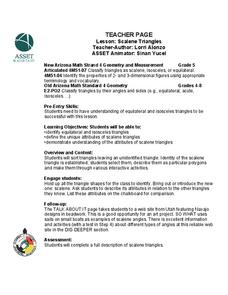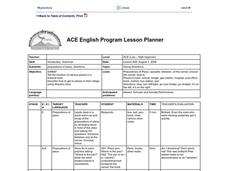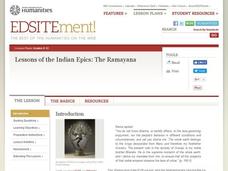Curated OER
Fields of Candy Bars
Young scholars research and write about the origins of the ingredients in candy bars. They taste them and describe what they are tasting. They use descriptive words to write a paragraph describing the candy bar. They research...
Curated OER
Sorting Quadrilaterals
Tenth graders investigate the geometric concept of quadrilaterals. They are given a set of shapes and asked to sort the quadrilaterals from the others. Then working in pairs they discuss the characteristics and write down the description...
Curated OER
Geographical Features
Fourth graders explore geographical features through the creation and construction of an original island. In small groups they write a description and draw a blueprint of their island using a draw/paint computer program, and using...
Curated OER
The Water Cycle
Fifth graders examine the stages of the continuous water cycle that exists on Earth. They observe a water cycle model that is set up in the classroom and write descriptions of what they see. As a class, they discuss models of the water...
Curated OER
Family Pictures
Fourth graders, after reading the story, "Family Pictures," discuss the format of the story and then recall a favorite family experience of their own. They then write a paragraph as modeled by the author describing that experience with...
Curated OER
Critters R Us or Crime Scene Critters
Learners identify nocturnal animals in their local area. Using the internet, they view animal tracks to determine which ones might be in around their school. In groups, they examine outside areas and record their observations. They...
Curated OER
What time is it, Mr. Clock?
Learners practice telling time through movement, teamwork and cooperation - as they demonstrate how a clock represents time. They play a game of telling time in order to master the lesson objectives.
Curated OER
Describing Chemical Reactions
In this chemical reactions instructional activity, students fill in 12 blanks with the appropriate terms related to chemical reactions. They also indicate if 4 statements are true or false and match 7 words with their descriptions....
Curated OER
Types of Chemical Reactions
In this chemical reactions learning exercise, students fill in 12 blanks, determine if 5 statements are true or false, match 4 types of reactions with their description and solve 2 problems related to balancing equations and chemical...
Curated OER
Lines Composed a Few Miles Above Tintern Abbey
Twelfth graders read lyrics for "My Hometown" and complete a worksheet to identify setting and tone in the song. For this Romanticism lesson, 12th graders read Lines Composed a Few Miles Above Tintern Abbey by Wordsworth and discuss...
Curated OER
The Touch N Feel Box
Students discover the characteristics of living and non living objects without the use of sight. In this sense of touch lesson, students touch items put in a shoe box and must identify whether the item was once living or not by...
Curated OER
Moccasins are Made for Dancing
Students perform a traditional Native American dance. In this cultural dance instructional activity, students research two Native American dances. Students discuss the relationship between the dances and Native American...
Curated OER
Reading and Writing Program Using Core Knowledge Literature
Students improve their reading and writing skills using Step Up to Writing and Six Traits of Writing techniques. Students complete a Robinson Crusoe vocabulary crossword, a Treasure Island character analysis web, reading comprehension...
Curated OER
George Washington: Our First President
Young scholars explore the life of George Washington. In this George Washington lesson, students consider the leadership qualities of the first president as they listen to a description of his life and the create responsibility journals.
Curated OER
Sun and Moon Poetry Baskets
Students write Sun and Moon poetry. In this poetry lesson, students research the sun and the moon. They write poetry and create two class baskets for descriptive words about each.
Curated OER
Landscape
Students create a landscape or cityscape. In this landscape lesson, students discover the definition of a landscape and describe various examples. Students choose three images and write "postcards" from each of the three...
Curated OER
Scalene Triangles
Fifth graders identify and classify scalene, equilateral, and isosceles triangles. In this triangle instructional activity, 5th graders define the different attributes of 3 types of triangles and sort them by descriptions and...
Curated OER
Giving Directions
Students explore communication by participating in language description activities. In this directions instructional activity, students practice using communicative terms and prepositions of places to direct a classmate to an exact...
Curated OER
How Animals Bond
In this animals lesson plan, young scholars students write a description about a pet or animal that they know. They include details that would help someone who has never met their animal feel like they know it already. Artwork about...
Curated OER
Eastern Woodland Indians
Fifth graders research the Eastern Woodland Indians in this lesson. They list the tribes and write a description of the physical environment. They list examples of the types of food, clothing, transportation, home/shelter,...
Curated OER
Tour of the Frozen Ground
Students discuss and observe permafrost features in their local community and compare and contrast these features with those described in a novel. In this permafrost lesson plan, students invite an elder from their community to discuss...
Curated OER
Lessons of the Indian Epics: The Ramayana
Students read a version of Ramayana and explore the elements of the epic hero cycle. In this Ramayana analysis lesson plan, students retell the basic narrative of the Ramayana and identify the main characters. Students identify elements...
Curated OER
The President’s Cabinet
In this presidential cabinet worksheet, students read the 15 descriptions of Cabinet positions and match them to the appropriate titles.
Curated OER
Cesar Chavez Quilt Stories
Students create a 'quilt' to represent what they remember about Ceasar Chaves. In this reading instructional activity, students also complete descriptions of the picture that they decided to draw.























